The Twisting Bifurcations of Double Homoclinic Loops with Resonant Eigenvalues
Abstract
The twisting bifurcations of double homoclinic loops with resonant eigenvalues are investigated in four-dimensional systems. The coexistence or noncoexistence of large 1-homoclinic orbit and large 1-periodic orbit near double homoclinic loops is given. The existence or nonexistence of saddle-node bifurcation surfaces is obtained. Finally, the complete bifurcation diagrams and bifurcation curves are also given under different cases. Moreover, the methods adopted in this paper can be extended to a higher dimensional system.
1. Introduction and Setting of the Problem
In recent years, there is a large literature concerning the bifurcation problems of homoclinic and heteroclinic loops in dynamical systems (see [1–23] and the references therein). However, to the best of the authors’ knowledge, less attention has been devoted to the bifurcation of double homoclinic loops. Han and Bi [24] investigated the existence of homoclinic bifurcation curves and small and large limit cycles bifurcated from a double homoclinic loop under multiple parameter perturbations for general planar systems. Han and Chen [25] gave the number of limit cycles near double homoclinic loops under perturbations in planar Hamiltonian systems. Homburg and Knobloch [26] considered the existence of two homoclinic orbits in the bellows configuration, where the homoclinic orbits approach the equilibrium along the same direction for positive and negative times in conservative and reversible systems. Morales et al. [27, 28] presented contracting and expanding Lorenz attractors through resonant double homoclinic loops. Lu [29] obtained codimension 2 bifurcations of twisted double homoclinic loops in higher dimensional systems. Ragazzo [30] investigated the stability of sets that were generalizations of the simple pendulum double homoclinic loop. In our recent work [31, 32], codimension 2 bifurcations of double homoclinic loops and codimension 3 bifurcations of nontwisted double homoclinic loops with resonant eigenvalues were studied. Concerning this topic, a more extensive list of references can be found in the references mentioned earlier. Generally speaking, when studying the problem of single homoclinic or heteroclinic bifurcation connecting hyperbolic equilibrium, the bifurcation is more complicated as Γ is twisted. Moreover, it is known that double homoclinic loops have higher codimension than a single homoclinic loop under the same conditions. Therefore, it will be more challenging and difficult to analyze the twisting bifurcations of double homoclinic loops.
In this paper, on the one hand, using the method which was originally established in [22, 23] and then improved in [9, 17, 21], and so forth, we study the bifurcations of double homoclinic loops with resonant eigenvalues under twisted cases. Besides, the method is more applicable and bifurcation equations obtained in this paper are easier to compute. On the other hand, frequently, the too many equivalent terms in the bifurcation equation will make the bifurcation equation more complex so that it is very difficult to analyze the bifurcation equation. Applying the method used by Homburg and Knobloch [26] to analyze the center-stable and center-unstable tangent bundles, we cannot only get a smooth coordinate transformation in the neighborhood of Γ small enough, but also make the bifurcation equation definite under an additional condition. Such strategy in dealing with the problems of bifurcations from homoclinic and heteroclinic loops is rarely used in the existing literatures. Therefore, a main feature in this paper is a combination of geometrical and analytical methods.
-
H1 The linearization Df(0) has simple real eigenvalues at the equilibrium 0 : −ρ2, −ρ1, λ1, λ2 satisfying
() -
H2 System (2) has double homoclinic loops Γ = Γ1 ∪ Γ2, Γi = {z = ri(t) : t ∈ R, ri(±∞) = 0} and , i = 1,2, where Ws and Wu are the stable and unstable manifolds of 0, respectively.
-
H3 Let , and , unit eigenvectors corresponding to λ1 and −ρ1, respectively, and satisfying , .
-
H4 as t ≫ 1, and as t ≪ −1, i = 1,2.
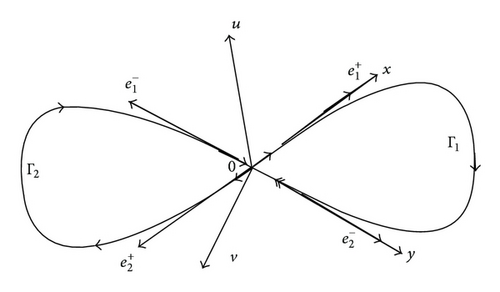
As shown in Figure 1, under the hypotheses (H1)–(H4), we can see that the double homoclinic loops Γ are of codimension 3.
The single homoclinic loop in high-dimensional systems has been investigated by many authors (see [1, 2, 4–8, 13–15, 17, 21, 22] and the references therein). In this paper, we only focus on bifurcations of the large loop; that is, the double loops Γ = Γ1 ∪ Γ2.
A nondegenerate homoclinic orbit is called a nontwisted homoclinic orbit if the unstable manifold Wu has an even number of half-twists along the homoclinic orbit, and is called a twisted homoclinic orbit if Wu has an odd number of half-twists along the homoclinic orbit; see more details in Deng [4]. A characterization for a twisted homoclinic orbit is that it arises from and tends to the equilibrium point from different sides of the unstable manifold. However, a nontwisted homoclinic orbit does so from the same side of the manifold. For the double homoclinic loop, Γ = Γ1 ∪ Γ2, it is called double twisted if both Γ1 and Γ2 are twisted, single twisted if and only if one of them is twisted, and nontwisted otherwise.
The rest of this paper is organized as follows. In Section 2, the normal form in a neighborhood of the equilibrium small enough is established and the bifurcation equations are given. In Section 3, by bifurcation analysis, the results of twisting bifurcations and complete bifurcation diagrams are obtained under different cases. We end the paper with a conclusion in Section 4.
2. Normal Form and Bifurcation Equations
From the hypothesis (H1), we can see that we confine ourselves to consider the resonance taking place between the two principal eigenvalues λ1 and −ρ1. Moreover, the corresponding eigenvectors are also the tangent directions of the homoclinic orbits. For simplicity, we may choose a new parameter μ = (α, ν) such that ρ1(μ) = λ1(ν) + αλ1(ν), −1 ≪ α ≪ 1.
-
(H5) H1(x, 0,0) = 0, H2(0, y, 0) = 0; that is,
()
3. Bifurcation Analysis
Denote that . We say that Γ is nontwisted as Δ1 = Δ2 = 1 and twisted as Δ1 = Δ2 = −1 or Δ1Δ2 = −1. In this paper, we focus on the twisted bifurcations. It is easy to see that is the approximate expanding rate of the solution from to .
Case 1 (Δ1 = Δ2 = − 1 (i.e., double twisted)). For convenience and simplicity, we use the following notations throughout Case 1:
Similarly, by setting , we can derive that s1(ν) increases along the direction for ν near as α < 0.
By a similar procedure, we can show that s2(ν) increases along the direction as ν is in the neighborhood of and α < 0.
Summing up the previous analysis, we have the following theorem.
Theorem 1. Suppose that (H1)–(H5) hold; then, the following conclusions are true.
- (1)
If , then there exists a unique surface Σi with codimension 1 and normal vectors at ν = 0, such that system (1) has a homoclinic loop near Γi if and only if ν ∈ Σi and |ν | ≪ 1. If , then Σ12 = Σ1∩Σ2 is a codimension 2 surface and 0 ∈ Σ12 such that system (1) has a large loop consisting of two homoclinic orbits near Γ as ν ∈ Σ12 and |ν | ≪ 1; that is, Γ is persistent.
- (2)
In the region , there exists a large 1-homoclinic orbit bifurcation surface which is tangent to Σ2 (resp., Σ1) at ν = 0 with the normal vector (resp., ) as α > 0 (resp., α < 0), and for , system (1) has a unique large 1-homoclinic orbit near Γ. Furthermore, the unique large 1-homoclinic orbit near Γ becomes a large 1-periodic orbit when ν moves along the direction (resp., ) and nearby as α > 0 (resp., α < 0). Meanwhile, there exists another large 1-homoclinic orbit bifurcation surface which is tangent to Σ1 (resp., Σ2) at ν = 0 with the normal (resp., ) as α > 0 (resp., α < 0), and for , system (1) has another one unique large 1-homoclinic orbit near Γ. Furthermore, the unique large 1-homoclinic orbit near Γ changes into a large 1-periodic orbit when ν shifts along the direction (resp., ) and near as α > 0 (resp., α < 0).
Lemma 2. Suppose that hypotheses (H1)–(H5) and 0 < α ≪ 1 are valid; then, in addition to the large 1-homoclinic loop , system (1) has exactly one simple large 1-periodic orbit near Γ for . Moreover, the large 1-periodic orbit is persistent as ν changes in the neighborhood of .
Proof. If and |ν | ≪ 1, then we know that system (1) has one large 1-homoclinic loop . Now, following (6), we have
Let . Then,
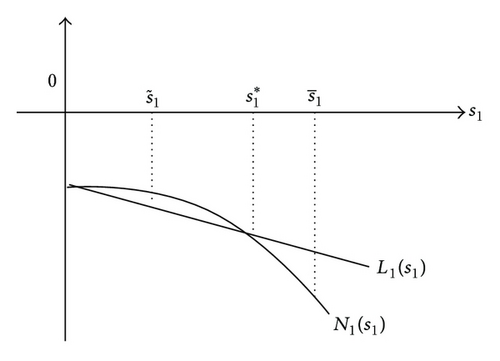
Lemma 3. Suppose that hypotheses (H1)–(H5) and 0 < α ≪ 1 hold. Then, system (1) has a saddle-node bifurcation surface of large 1-periodic orbit in the region as follows:
Proof. It is easy to see that h = N1(s1) is tangent to h = L1(s1) at some point s1, as shown in Figure 3; if
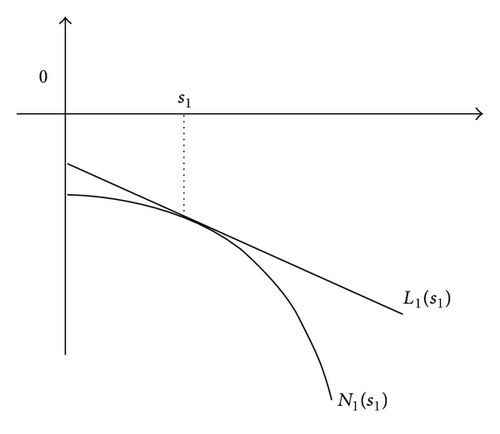
Remark 4. Due to , we see that the line L1(s1) lies above the curve N1(s1) as ν ∈ SN2. Moreover, . decreases as and ν moves along the direction ; in this case, system (1) exhibits two large 1-periodic orbits. And as ν leaves SN2 along the opposite direction, there is no large 1-periodic orbit.
Corollary 5. The bifurcation surface {0 < α ≪ 1} × SN2 and the region have no intersection point.
Proof. Let , where 0 < a < δ−1e2 is a given constant; then, in view of and (1 + α) 1/α → e as α → 0, we know the right side of the expression SN2 as follows:
Corollary 6. As , the bifurcation surface {0 < α ≪ 1} × SN2 and the region have no intersection point.
Proof. Still let , where 0 < a < δ−1e2 is a given constant; then, due to , we know that
By a similar analysis as in Lemmas 2 and 3, we can obtain the following results.
Lemma 7. Suppose that hypotheses (H1)–(H5) and 0 < α ≪ 1 are valid; then, in addition to the large 1-homoclinic loop , system (1) has exactly one simple large 1-periodic orbit near Γ for . Moreover, the large 1-periodic orbit is persistent as ν changes in the neighborhood of .
Lemma 8. Suppose that hypotheses (H1)–(H5) and 0 < α ≪ 1 hold. Then, system (1) has a saddle-node bifurcation surface of large 1-periodic orbit in the region as follows:
Remark 9. Let and . Due to and ., we claim that the line L2(s2) lies above the curve N2(s2) as ν ∈ SN1, and when and ν leaves SN1 along the direction , L2(0) decreases; hence, system (1) has two large 1-periodic orbits, and when ν moves along the direction , there is no large 1-periodic orbit.
Corollary 10. The bifurcation surface {0 < α ≪ 1} × SN1 and the region have no intersection point.
Corollary 11. As , the bifurcation surface {0 < α ≪ 1} × SN1 and the region have no intersection point.
In the following we define open regions in the neighborhood of the origin of the ν-space, which are shown in Figures 4 and 5.
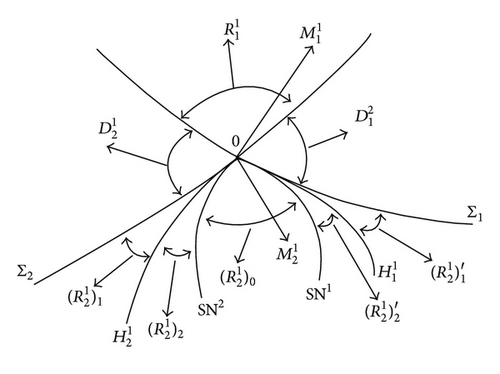
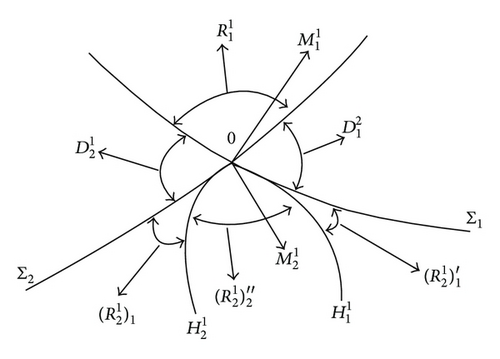
is bounded by SN1 and SN2, is bounded by Σ2 and , is bounded by and SN2, is bounded by SN1 and SN2, is bounded by SN1 and , is bounded by Σ1 and Σ2, and is bounded by and .
Now, the previous analysis is summarized in the following three theorems, as shown in Figures 4 and 5.
Theorem 12. Suppose that hypotheses (H1)–(H5) hold, 0 < α ≪ 1, , , and . Then, system (1)
- (1)
has exactly one simple large 1-periodic orbit near Γ as ;
- (2)
has a unique double large 1-periodic orbit near Γ as ν ∈ SN2;
- (3)
has exactly two simple large 1-periodic orbits near Γ as ;
- (4)
has exactly one simple large 1-periodic orbit and one large 1-homoclinic loop near Γ as ;
- (5)
does not have any large 1-periodic and large 1-homoclinic loop near Γ as ;
- (6)
has exactly one simple large 1-periodic orbit near Γ as ;
- (7)
has a unique double large 1-periodic orbit near Γ as ν ∈ SN1;
- (8)
has exactly two simple large 1-periodic orbits near Γ as ;
- (9)
has exactly one simple large 1-periodic orbit and one large 1-homoclinic loop near Γ as .
Theorem 13. Suppose that hypotheses (H1)–(H5) hold, 0 < α ≪ 1, , , and . Then system (1)
- (1)
has exactly one simple large 1-periodic orbit near Γ as ;
- (2)
has exactly one simple large 1-periodic orbit and one large 1-homoclinic loop near Γ as ;
- (3)
has exactly two simple large 1-periodic orbits near Γ as ;
- (4)
has exactly one simple large 1-periodic orbit and one large 1-homoclinic loop near Γ as ;
- (5)
has exactly one simple large 1-periodic orbit near Γ as .
Remark 14. Suppose that hypotheses (H1)–(H5) hold, 0 < α ≪ 1, , ; then the conclusions of Theorem 13 are still true, and the bifurcation diagram is the same as Figure 5.
Denote by the open region with boundaries Σ1 and Σ2, such that . is the open region with boundaries Σ2 and Σ1, such that .
From the bifurcation equations (6), we have the following theorem.
Theorem 15. Suppose that hypotheses (H1)–(H5) hold, and 0 < α ≪ 1. Then, system (1)
- (1)
does not have any large 1-periodic orbit near Γ as ;
- (2)
does not have any large 1-periodic orbit near Γ as ;
- (3)
does not have any large 1-periodic orbit near Γ as .
Remark 16. For −1 ≪ α < 0, by the same analysis, we can obtain the analogous results as those in Theorems 12–15. In fact, in the case we can reverse the time t and change (x, y, u, v) to (y, x, v, u), and then we still get 0 < α ≪ 1.
For the same reason as before, we have the following theorem.
Theorem 17. Suppose that (H1)–(H5), α = 0, and hold; then,
- (1)
as , system (1) not only has a large 1-homoclinic orbit bifurcation surface
()with a normal vector at ν = 0, but also has another large 1-homoclinic orbit bifurcation surface()with a normal vector at ν = 0, - (2)
as either , , and or , , and , system (1) has a unique large 1-periodic orbit near Γ.
Case 2 (Δ1 = −1, Δ2 = 1 (i.e., single twisted)). Similar to Case 1, for convenience and simplicity, we use the following notations:
If (6) has a solution s1 = s2 = 0, then we have
Suppose that (6) has solution s1 = 0, s2 > 0. Then, we have
Similarly, by setting , we can derive that s1(ν) increases along the direction for near as α > 0.
If (6) has solution s1 > 0 and s2 = 0, then we get
By a similar procedure, we can show that s2(ν) increases along the direction as ν is in the neighborhood of and α < 0.
Summarizing the previous analysis, we have the following theorem.
Theorem 18. Suppose that (H1)–(H5) hold; then, the following conclusions are true.
- (1)
If , then there exists a unique surface with codimension 1 and normal vectors at ν = 0, such that system (1) has a homoclinic loop near Γi if and only if and |ν | ≪ 1. If , then is a codimension 2 surface and such that system (1) has a large loop consisting of two homoclinic orbits near Γ as and |ν | ≪ 1; that is, Γ is persistent.
- (2)
In the region , there exists a unique large 1-homoclinic orbit bifurcation surface which is tangent to (resp., ) at ν = 0 with the normal vector (resp., ) as α > 0 (resp., α < 0), and for , system (1) has a unique large 1-homoclinic orbit near Γ. Furthermore, the unique large 1-homoclinic orbit near Γ becomes a large 1-periodic orbit when ν moves along the direction (resp., ) and nearby as α > 0 (resp., α < 0). In the region , there exists another unique large 1-homoclinic orbit bifurcation surface which is tangent to (resp., ) at ν = 0 with the normal (resp., ) as α > 0 (resp., α < 0), and for , system (1) has another one unique large 1-homoclinic orbit near Γ. Furthermore, the unique large 1-homoclinic orbit near Γ changes into a large 1-periodic orbit when ν shifts along the direction (resp., ) and nearby as α > 0 (resp., α < 0).
Lemma 19. Suppose that hypotheses (H1)–(H5) and 0 < α ≪ 1 are valid; system (1) has only a unique large 1-homoclinic orbit near Γ for and 0<|ν | ≪ 1.
Proof. If and |ν | ≪ 1, from Theorem 18, we know that system (1) has one large 1-homoclinic loop . Now, following (6), we have
Therefore, system (1) has only a unique large 1-homoclinic orbit near Γ for and 0<|ν | ≪ 1.

Remark 20. Due to , we can see that the line N1(s1) lies under the curve L1(s1) as . Moreover, . decreases as and ν moves along the direction ; in this case, system (1) has a unique large 1-periodic orbit. And as ν leaves along the opposite direction, there is no large 1-periodic orbit.
By a similar analysis as in Lemma 19, we can obtain the following results.
Lemma 21. Suppose that hypotheses (H1)–(H5) and 0 < α ≪ 1 are valid; system (1) has only a unique large 1-homoclinic orbit near Γ for and 0<|ν | ≪ 1.
Remark 22. Let and . Due to and ., we claim that the line L2(s2) lies under the curve N2(s2) as , and when and ν leaves along the direction , L2(0) increases; hence, system (1) has a unique large 1-periodic orbit, and when ν moves along the direction , there is no large 1-periodic orbit.
In the following we define open regions in the neighborhood of the origin of the ν-space, which are shown in Figure 7.
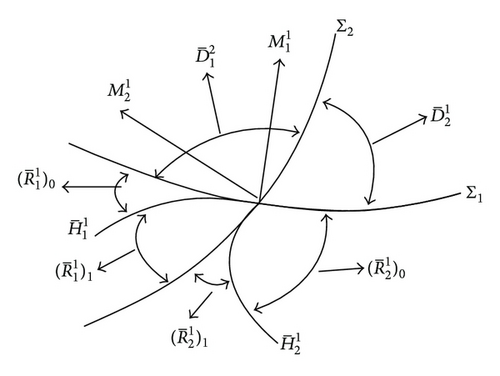
is bounded by Σ1 and , is bounded by Σ2 and , is bounded by and Σ2, is bounded by Σ1 and , is bounded by Σ1 and Σ2, and is bounded by Σ2 and Σ1.
From the previous analysis, we obtain the following three theorems, as shown in Figure 7.
Theorem 23. Suppose that hypotheses (H1)–(H5) hold, 0 < α ≪ 1, . Then, system (1)
- (1)
does not have any large 1-periodic orbit and large 1-homoclinic loop near Γ as ;
- (2)
has a unique large 1-homoclinic loop near Γ as ;
- (3)
has a unique large 1-periodic orbit near Γ as .
Theorem 24. Suppose that hypotheses (H1)–(H5) hold, 0 < α ≪ 1, . Then, system (1)
- (1)
has no large 1-periodic orbit and large 1-homoclinic loop near Γ as ;
- (2)
has a unique large 1-homoclinic loop near Γ as ;
- (3)
has a unique large 1-periodic orbit near Γ as .
From the bifurcation equations, we have the following theorem easily.
Theorem 25. Suppose that hypotheses (H1)–(H5) hold, and 0 < α ≪ 1. Then, system (1)
- (1)
has no large 1-periodic orbit near Γ as ;
- (2)
has no large 1-periodic orbit near Γ as .
Remark 26. For −1 ≪ α < 0, by the same analysis, we can obtain the analogous results as those in Theorems 23–25. In fact, in the case we can reverse the time t and change (x, y, u, v) to (y, x, v, u), and then we still get 0 < α ≪ 1.
For the same reason as before, we have the following theorem.
Theorem 27. Suppose that (H1)–(H5), α = 0, and hold; then,
Remark 28. As Γ1 is nontwisted and Γ2 is twisted, we can obtain similar conclusions as shown in Case 2.
4. Conclusion
This paper is devoted to investigating the twisting bifurcations of double homoclinic loops with resonant eigenvalues in 4-dimensional systems. We give asymptotic expressions of the bifurcation surfaces and their relative positions, describe the existence regions of large 1-periodic orbits near Γ in Lemmas 2 and 7, and obtain the sufficient conditions for the existence or nonexistence of saddle-node bifurcation surfaces in Lemmas 3 and 8. More importantly, the complete bifurcation diagrams are given under different cases in Figures 4, 5, and 7. According to our analysis, when Γ is double twisted, in Theorems 12–15, we obtain one bifurcation diagram with saddle-node bifurcation surfaces of large 1-periodic orbit when and the other bifurcation diagram without saddle-node bifurcation surfaces when . When Γ is single twisted, in Theorems 23–25, we obtain another bifurcation diagram. Compared with the nontwisted cases in Zhang et al. [32], our paper shows completely different results and bifurcation diagrams. It is worthy to be mentioned that the restriction on the dimension is not essential, the method used in this paper can be extended to higher dimensional systems without any difficulty, and the same conclusions can be deduced under the same hypotheses. Furthermore, we mention some problems for future study. (1) Ws or Wu is inclination flip on one of the double homoclinic loops. (2) Both Ws and Wu are inclination flips on the double homoclinic loops and so on. But the difficulty of these problems will increase with adding codimension of the double homoclinic loops.
Acknowledgments
The research was supported by National Natural Science Foundation of China (nos. 11001041, 11101170, 11202192, 11271065 and 10926105), SRFDP (no. 200802001008), and the State Scholarship Fund of the China Scholarship Council (nos. 2011662521, and 2011842509).




